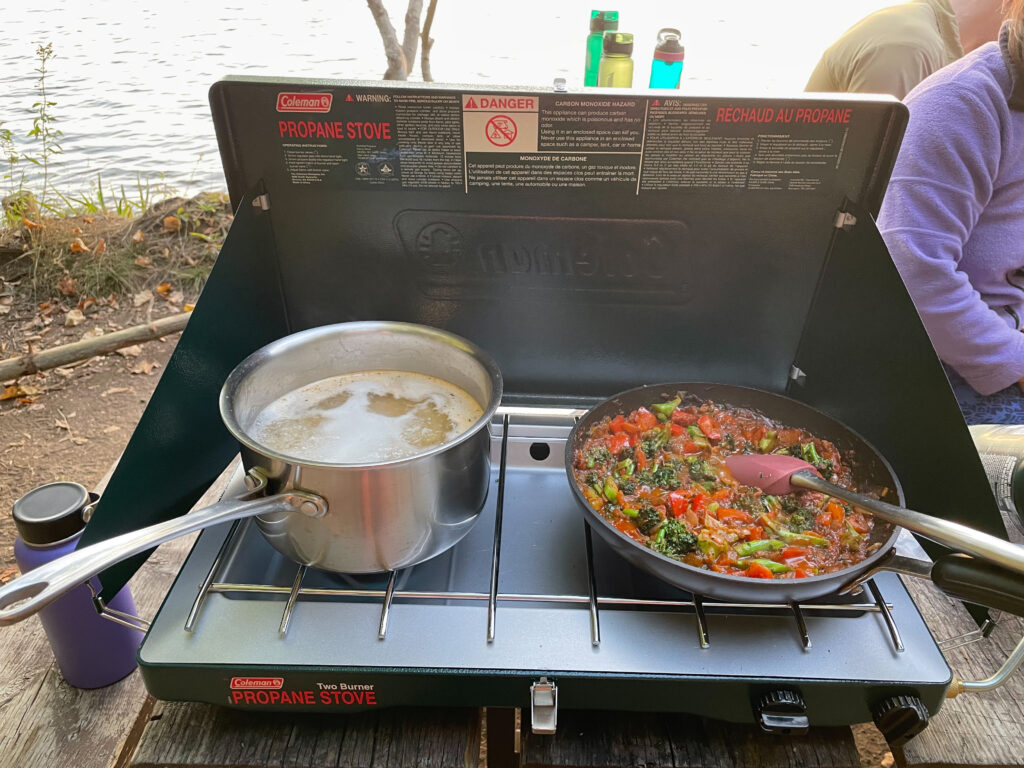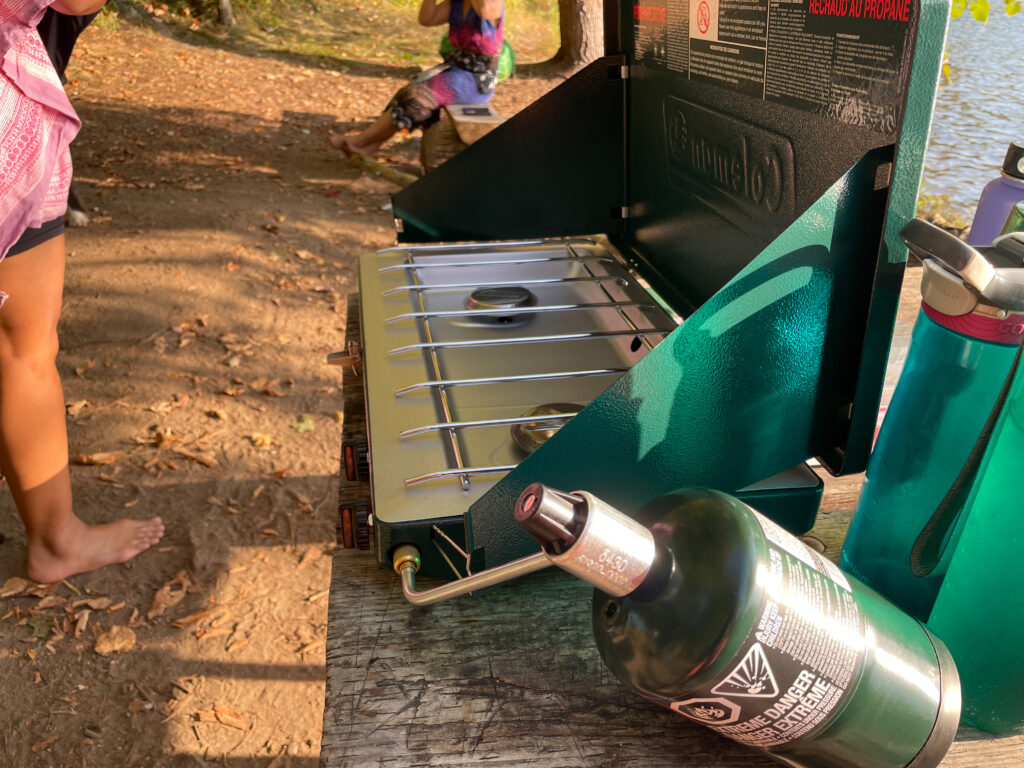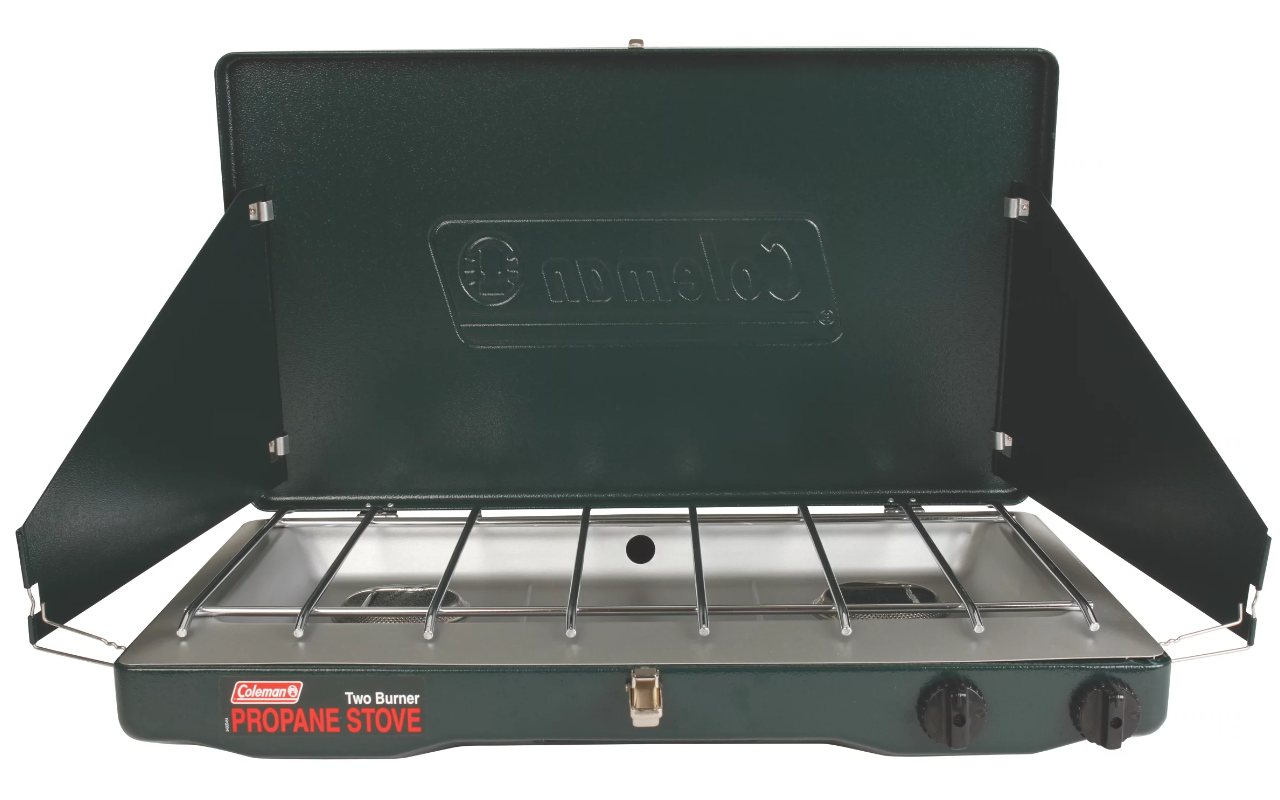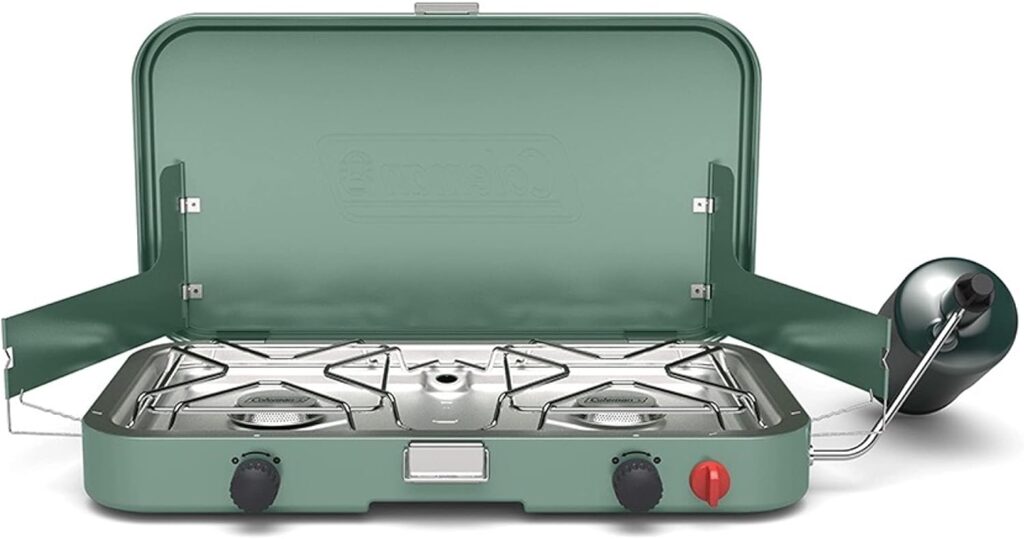A propane camping stove is a great way to cook while camping.
There’s no need to fuss with complicated fuel lines or fuel pressure like there is for a liquid fuel camp stove. It’s also more efficient at boiling water than a butane camp stove.
Propane camp stoves are used by most car campers since they’re reliable, safe and relatively inexpensive.
Personally, when I started camping, one of my first purchases was a dual burner propane camp stove that I used for over 10 years!
So, let’s find out everything there is to know about how to use a propane stove and why a propane stove is a great choice for camping.
Article Contents:
- What is a Propane Camping Stove?
- Advantages of Using a Propane Stove
- Disadvantages of Using a Propane Stove
- How to Properly Use a Propane Camping Stove
- Best Propane Camping Stoves
What is a Propane Camping Stove?

When it comes to cooking outdoors, there are many options available. The three most common types of stoves are liquid fuel (naphtha), butane, and propane.
For most campers and camping situations, a propane stove would be the most reliable and cost effective.
A propane camp stove uses propane, a highly flammable, liquefied gas, to fuel a burner and provide a consistent heating source for cooking.
- Propane is a fairly common fuel and used in many applications, including portable blow-torches and BBQs.
- It burns at over 1,900oC (3,500oF).
- Under pressure, propane is a liquid, and only when the pressure releases does it change into a gas.
There are a number of advantages and disadvantages of using a propane camp stove. Let’s go through them both.
Pro-tip: If you’re looking for information on inexpensive camp stoves, check out my article Should You Buy a Coleman Camp Stove.
Advantages of Using a Propane Stove
1. Propane Bottles
The primary advantage of using a propane stove are the propane bottles.
- Propane bottles are convenient, low-maintenance, low cost (up to a point) and contain a relatively large amount of fuel.
There’s no need to worry about refilling or spilling liquid fuel. All you do is screw in a bottle and you’re good to go!
A standard propane bottle contains 453 grams (16 ounces) of fuel. I’ve cooked multiple, long cooking time meals including pasta, steak, and stir-fry vegetables all from a single bottle.
For me, a single propane bottle can cook up to 4 full meals (not dehydrated packages) for 4 adults, including boiling water for hot drinks up to 4 times.
2. Safe and Reliable Operation
Propane stoves are very reliable and safe to use while camping – young campers and newbies can be shown how to operate them easily.
- My wife, who usually struggles with our liquid fuel camp stove, can operate our propane stove without any issues.
For a multi-day camping trip, with moderate to high cooking requirements, a propane fueled camp stove is an excellent choice.
3. Cold Weather Compatible
The biggest drawback of liquefied gases, like propane and butane, are their reliance on the ambient temperature.
Propane bottles contain a mixture of liquid and gas in equilibrium. As the gas is used, the liquid fuel evaporates and produces gas. But, as we all learned in elementary school, liquids can only evaporate if the temperature is high enough.
- If it gets too cold, there isn’t enough ambient heat energy for the liquid in the bottle to turn into gas which is what drives the pressure in the canister to push out the fuel.
- An added complication is that as the fuel is used, the bottle itself cools. After extended use, this can cause the internal temperature to drop. The gas flow will drop drastically and the stove won’t be able to operate as normal. You’ll need to wait until the canister warms back up to use it again.
However, unlike butane canisters which stop working around 0° Celsius, propane has a much lower operating temperature.
- Propane bottles can operate down to -40° Celsius (-40° Fahrenheit).
So, for cold weather camping, including winter camping, a propane fueled stove will work. Alternatively, liquid fuel and isobutane are also recommended.

Disadvantages of Using a Propane Stove
1. Weight of Multiple Bottles
Although individual propane bottles weigh 1 pound, depending on the duration of your trip and the total cooking time you’re planning, the number of propane bottles can add up.
Multiple filled (and empty) propane bottles start adding to your overall pack weight.
2. Price per Cooking Hour
Gas stoves are usually cheaper than liquid fuel stoves. However, propane is slightly more expensive than liquid fuel, on a per hour of cooking basis.
Based on my testing, in controlled settings, propane is 4% more costly for cooking compared to naphtha (liquid).
3. Fuel Availability
Outside North America, propane bottles are harder to come across. Liquid fuel is much readily available and used.
- For international trips, liquid fueled stoves are definitely highly recommended since fuel (gas or liquid) cannot be transported on an airplane.
So, once at your destination, you should be able to more easily access liquid fuel sources.
Also, liquid fuel stoves denoted as “dual fuel”, which means that they can run on naphtha or gasoline, are even more versatile for international travel to remote areas.
How to Properly Use a Propane Camping Stove

To properly and safely use a propane gas camping stove, follow these steps:
Step 1 – Assemble Stove with Fuel Line
Assemble the stove by unlocking and opening the lid, unfolding the windscreens and locking them into place, and installing the fuel line.
Ensure the gas flow dials on the stove are in the “Off” position.
Step 2 – Install Propane Bottle
Position the fuel line so that the bottle connection point (i.e., fuel flow regulator valve) is facing upward. This will make screwing on the propane bottle much easier.
Remove the protective plastic cap on the 1-pound propane bottle. Screw the bottle into the regulator valve.
Rotate the fuel line with the bottle connection so that the bottle sits on the table with the regulator valve pointing upward.
Step 3 – Ignite Gas
Some propane stoves come with a built-in igniter. To use this function, turn the fuel dial towards the open position. Once gas can be heard flowing, press the built-in igniter button. You should hear a click and the gas should ignite.
If your stove does not have built-in lighter, ignite a portable lighter or match first. Position the flame close to and over the edge of the burner. Turn the fuel dial towards the open position to begin the flow of gas and the gas should ignite.
Step 4 – Adjust Gas Flow and Windscreens
Turn the fuel dial to adjust the flow of gas to the burner. In windy conditions, you may have to use a higher gas flow to compensate.
If required, reposition the built-in windscreens to better deflect wind away from the burners. For added wind protection, create a make-shift windscreen from wood, large rocks or even a cooler.
However, ensure the screen is kept far enough away from your stove to keep the flame from heating the surface.
Step 5 – Return Stove to Safe State
To turn off the stove and keep it in a safe state, completely turn the gas fuel dials to the off position once you’re finished cooking.
The propane bottle can remain connected to the fuel line.
Let the stove cool out of direct sunlight to keep the bottle and stove from excessively heating up throughout the day
Once cooled, the built-in wind screens can be folding inwards and the lid can be closed and locked.
Best Propane Camping Stoves

Personally, for most of the trips that I go on, which include 3-4 day long car camping and easy canoe camping trips in the backcountry, I take a dual burner propane stove and two propane bottles. It’s very convenient for me and makes cooking a breeze.
I would highly recommend the following propane camp stoves because of their exceptional performance and low cost.
The Coleman Classic 2-Burner Propane Stove is the standard camp stove most campers choose to use. It’s simple, reliable, and gets the job done. It’s not overly complicated to use which makes it perfect for beginner and intermediate campers.
- 20,000 BTU cooking power
- Large cooking surface for simultaneous cooking of one 10” and one 12” pot.
- Built-in windscreens help deflect wind, improving heating efficiency
- A built-in carrying handle makes it easy for transporting.
The only downside is that this model does not come with a built-in igniter so you need to use a lighter or match.
However, for its low price, you can’t go wrong! We actually bought ours during an Amazon Prime Day sale for $63 CAD, which was 50% lower than full price!
The Coleman Cascade Classic 2-Burner Propane Stove is a marked improvement on the standard classic stove mentioned above.
Enhancements include finer fuel adjustment knobs for more precise cooking temperature control, slightly higher cooking power, and a built-in igniter for matchless lighting.
- 22,000 BTU cooking power.
- Large cooking surface for simultaneous cooking of one 10” and one 12” pot.
- Built-in windscreens help deflect wind, improving heating efficiency
- A built-in carrying handle makes it easy for transporting.
For those looking for a more user-friendly propane camping stove, you’ll want to pick one of these up!
This article contains affiliate links, which help support this blog at no cost to you!


